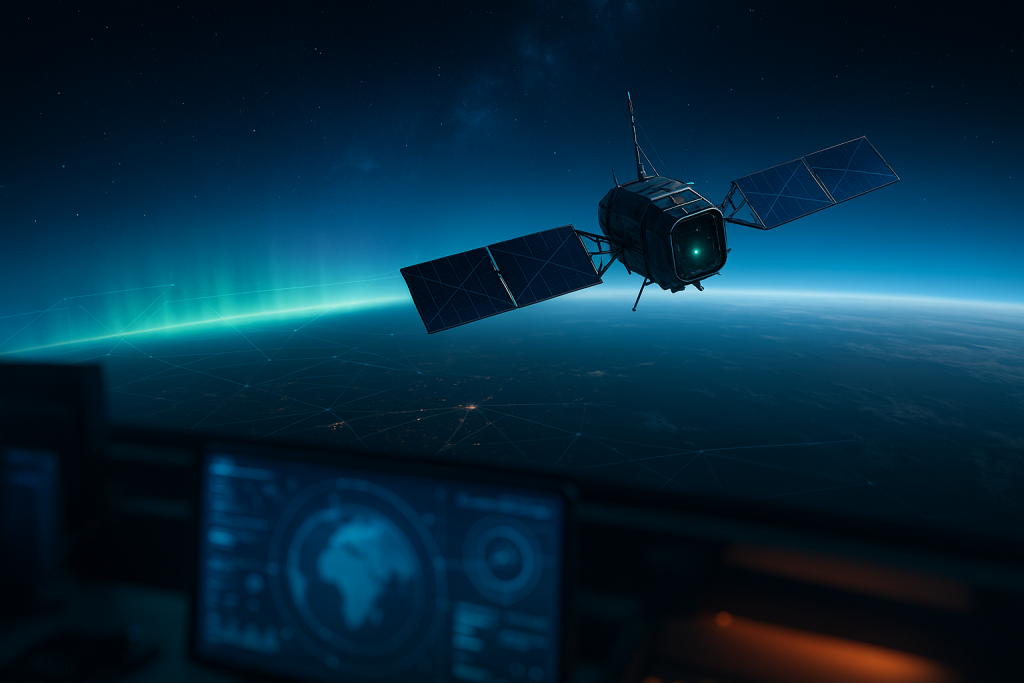Artificial intelligence has quietly become mission-critical infrastructure for space. What began as ground-based analytics that tagged clouds or stitched images has evolved into onboard autonomy that decides what to observe, how to navigate, when to talk to Earth, and how to keep hardware alive millions of kilometers away. From swarms of Earth-observation satellites to exploratory rovers on hostile terrain, AI is reshaping how we plan, fly, and sustain missions under extreme constraints.
From Telemetry to Foresight: Autonomy’s New Brain
Spacecraft generate torrents of telemetry—voltages, currents, temperatures, attitude estimates, RF metrics—far too much for humans to watch in real time. AI models transform this firehose into foresight, learning the normal rhythms of a vehicle and flagging subtle deviations before they snowball into faults. Instead of chasing alarms, operations teams receive ranked hypotheses and recommended mitigations, turning reactive firefighting into proactive care.
The Four Pillars: Perception, Prediction, Planning, Control
Modern space autonomy follows a simple but powerful pattern. Perception systems classify terrain, clouds, sea ice, dust storms, and stellar fields from cameras, radar, or hyperspectral sensors. Prediction models forecast orbital conjunction risk, thermal cycles, battery depth-of-discharge, or weather over ground stations. Planning engines schedule downlinks, target selection, and power budgets under hard constraints. Control loops execute the plan through reaction wheels, thrusters, antennas, and instrument settings—always with guardrails that keep physics and safety paramount.
Onboard Vision: Seeing What Matters, When It Matters
Downlink is the scarcest resource in space. Onboard computer vision triages data at the edge so only the most valuable bits come home. Satellites discard cloudy tiles automatically, pick the sharpest frames, compress intelligently, and even generate quicklook summaries. Maritime targets, wildfire plumes, algal blooms, volcanic ash, and flood extents can be detected in orbit, ensuring that priority scenes beat the queue and reach responders while they still matter.
Rovers and the Art of Moving Without Asking
Light-minute delays make joystick driving impossible on other worlds. Rovers rely on AI for terrain classification, slip estimation, and hazard avoidance, using stereo imagery or lidar to build local maps and choose safe steps. Path planners weigh risk against energy, sunlight, science payoff, and wheel wear. When conditions change—softer soil than expected, a steeper slope, a dust shadow—the autonomy stack replans on the fly and radios Earth a concise report of what changed and why.
Formation Flying and Swarm Coordination
Constellations and swarms multiply coverage but complicate choreography. AI agents coordinate phasing maneuvers, maintain baselines for interferometry, and share sensing tasks to avoid duplication. Multi-agent policies resolve conflicts, conserve propellant, and negotiate observation priorities, while a supervisory layer enforces keep-out zones and collision-avoidance rules so emergent behavior never becomes emergent chaos.
Ground Segment Intelligence: The Mission Behind the Mission
Much of the magic happens on the ground. Planners use AI to solve massive scheduling puzzles across satellites, ground stations, weather, and regulatory windows. Anomaly detectors digest years of historical ops to suggest likely root causes. Digital twins simulate the spacecraft and environment, letting teams rehearse procedures, validate autonomy updates, and derisk new modes long before they touch flight hardware.
Space Traffic Management and Conjunction Screening
Low Earth Orbit is crowded, and conjunction alerts can overwhelm operators with false positives. Machine-learned filters rank risk, estimate uncertainty in ephemerides, and propose maneuver windows that minimize propellant burn while preserving mission objectives. The result is fewer unnecessary avoidance maneuvers and faster consensus on the ones that matter.
Delay-Tolerant By Design: When Networks Break
Deep-space missions live with long outages and high latency. AI helps by packaging results into prioritized bundles, requesting missing context only when essential, and switching to opportunistic downlinks when a relay asset pops into view. Onboard summarizers turn raw science into compact findings, while ground systems reconstruct the full picture once the trickle of data arrives.
Ruggedized Intelligence: Computing Through Radiation and Scarcity
Space is unforgiving to silicon. Flight computers must balance compute-hungry models with strict limits on power, thermal load, memory, and fault tolerance. Engineers prune and quantize networks, run ensembles only where needed, and place critical logic on radiation-tolerant processors with watchdogs and safe-mode fallbacks. Non-critical AI runs as an advisor, never as a single point of failure, and every autonomous action is bounded by deterministic checks.
From Pixels to Policy: AI for Planetary Stewardship
Earth-observation constellations feed climate models, agricultural forecasts, disaster response, and maritime safety. AI closes the loop from raw pixels to decisions, mapping deforestation, tracking urban heat islands, monitoring reservoirs, and verifying emissions at facility scale. As latency drops and edge triage improves, insights move from monthly reports to daily tasking and near-real-time action.
Ethics, Safety, and the Human In the Loop
Autonomy must earn trust. Mission teams define explicit refusal rules, transparency logs, and escalation paths where humans approve high-risk actions. Safety cases document assumptions, training data lineage, and performance envelopes. For planetary protection and responsible orbit use, AI systems are tuned to avoid sensitive regions, respect debris mitigation norms, and surface uncertainty rather than bluffing confidence.
Design Playbook: Building Space-Ready AI
Successful flight AI begins with clear contracts, not clever models. Teams specify inputs, outputs, and invariants, then test against adversarial cases—glare, dust, radiation bitflips, sensor dropouts. Sim-to-real gaps are narrowed with domain randomization and field tests. Every update is evaluated with regression suites, shadow-mode rehearsals, and staged rollouts that allow instant rollback if telemetry disagrees with expectations.
What’s Next: Multimodal, Multi-Agent, and More Autonomous
The near future brings tighter fusion of vision, RF, thermal, and hyperspectral data in a single onboard model. Swarms will self-assign targets and share partial inferences to act as one sensor spread across dozens of vehicles. In deep space, explorers will conduct opportunistic science—spotting transient events, re-tasking instruments, and negotiating bandwidth—while keeping Earth informed through compact, human-readable summaries.
Conclusion
AI in space is not about replacing mission control—it is about giving spacecraft the judgment to handle the unforgiving moments when no one can help. By pairing perception with prediction, planning, and control, and by respecting the hard limits of power, bandwidth, and safety, orbital intelligence turns satellites and rovers into thoughtful collaborators. The payoff is profound: faster science, safer operations, smarter stewardship of Earth, and bolder exploration of everywhere else.


